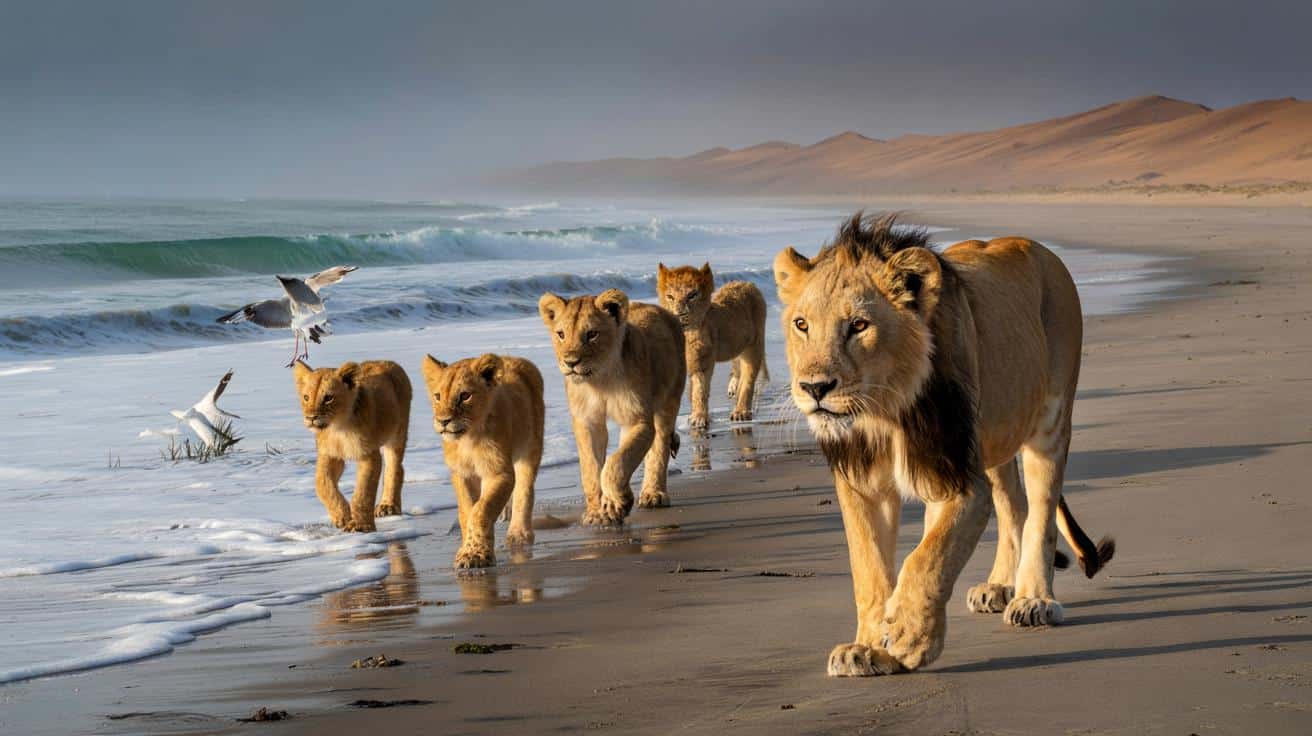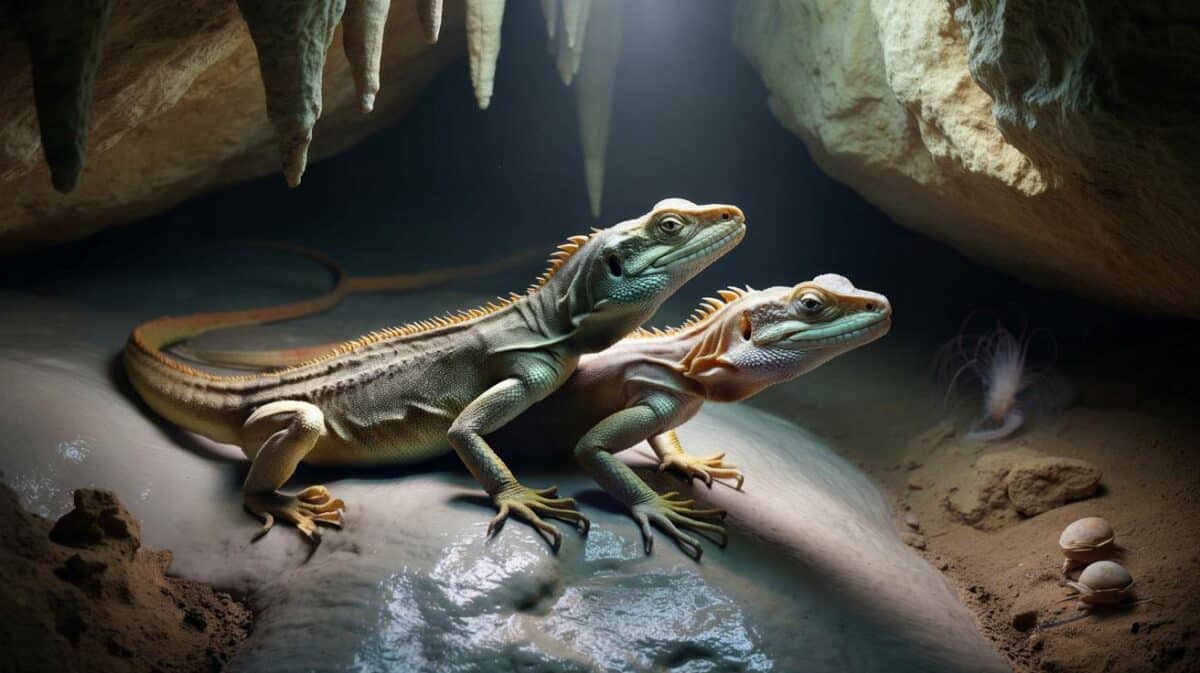A photographer followed them for months, watching a pride that left the desert and learned the tide. The result is a rare window into the world’s only lions known to feed from the shore.
The wind came in cold from the Atlantic, the kind that sneaks into sleeves and chills your ribs. Ahead, through a veil of mist, the first lioness trotted along the tideline as if she had always known the rhythm of waves, salt glowing on her whiskers like frost. Gulls rose in an annoyed flutter while the surf coughed and retreated, and the beach turned into a long, pale avenue that seemed to run forever. Behind a dune, the photographer steadied a long lens, breath slow, ears full of sea and sand. The lions paused at the kelp line and stared into the green. Then the sea answered.
The pride that swapped sand for surf
Out on Namibia’s Skeleton Coast, a small pride lives on the edge of two vast things: desert and ocean. They roam the dunes and then drop onto the beach like shadows, using the morning fog as cover and the noise of waves as camouflage. To watch them is to watch old instinct learn a new trick, and it rings in your chest because it feels both wrong and right at once.
One night the photographer sat with researchers, lights off, windows cracked for sound. The lions fanned out along the high-water mark, then the lead female broke into a sprint, arrowing for a dark shape rolling in the wash. It ended fast, almost quiet, the way wild things often do, and later the cubs became students, nosing the slick pelt while their mother looked to the horizon as if waiting for the next lesson.
Why the beach, and why now? Years of drought press life into corners where it once had plenty, and antelope that grazed the riverbeds don’t always show. The shore offers a new ledger: seabirds, carrion, and on rare nights, a seal unwary in the surf. Fog brings moisture to lick from fur and rocks, and the coastline becomes not a boundary but a corridor that carries scent and chance along its length.
How the images were made
The photographer worked with trackers who read dunes like stained glass. Mornings began by scanning for fresh prints where dry sand meets wet, then looping downwind to let the breeze carry scent away. Vehicles kept low and far, lenses did the walking, and shutters went silent long before the lions did. Patience was the only currency that held its value.
There were rules carved by experience, not ego. Don’t chase, ever. Don’t sit high on a ridge where you become a skyline; you’re a flag up there. Learn the fog because it tells you how sound travels and when a wave will drown your footsteps. Let’s be honest: nobody actually does this every day, and anyone who says they do is selling you a dream that skips the dull hours and the cold hands.
“The first time I saw a lioness watch the break like a fisherman watches current, I forgot to shoot,” the photographer told me. “I just let the camera rest and tried to breathe with the sea.”
In practice, the craft is simple and unforgiving: wait where tides bottle-neck scent, anticipate how wind will shift at sunrise, and never cut off a path back to the dunes.
- Pack a long lens and a beanbag, not bravado.
- Work with local scientists and communities; they hold the map under the map.
- Use **stay downwind** as a mantra, not an afterthought.
- Carry a small trash bag; leave the beach cleaner than you found it.
- Keep a note of fog times and swell size; **the ocean writes the schedule**.
What these lions mean for us
Stories we thought were fixed can be edited by weather, hunger, and nerve. A lion on a beach is an image that scrapes the inside of your head, and yet here they are, making sense of a world that’s changing its rules on the fly. We’ve all had that moment when the familiar flips strange, and it’s usually when we’re tired, a little scared, and awake in a way we hadn’t planned.
The photographs don’t just dazzle; they fold a landscape into an animal until you can’t tell where one ends and the other begins. Dunes become muscles, waves become breath, and a pride turns from a desert story into a shoreline one. What looks like novelty is often survival wearing new shoes.
Walk away from these images and you keep hearing the surf under their paws. It lingers because it says something quiet and large: that wildness is not a museum, and adaptation can be both brutal and beautiful. **The world’s only marine lions** are not a spectacle. They are a mirror tilted toward all of us.
Behind the lens was toil that doesn’t post well: long hours of nothing, maps that lie, and batteries that die the second the sky looks interesting. There’s risk in getting it wrong, and that risk belongs to the animals first. The win is simple and rare—one clean frame where behavior breathes and you feel like a witness instead of a thief.
Local people carry the oldest knowledge here, and their insight is often a compass when the dunes don’t care about your plans. A photograph that respects that lineage has more weight than a viral clip. The images that lasted weren’t the gory ones or the gotchas, but the quiet frames—the pride walking in a file along the foam, seaweed snagging a tail, the matriarch turning once, as if to check the tide chart made sense to her too.
Ethics is a daily verb. Don’t block, don’t bait, don’t brag. If a lion changes direction because of you, your picture isn’t a trophy, it’s a confession. The best moments came when the team forgot about getting “the shot” and started breathing in the rhythm of the place; the camera then followed almost as an afterthought.
On one fog-thick dawn, the cubs discovered a dead fish and made theater from it, batting and pouncing until the sea claimed what it had loaned. The photographer laughed under their breath, not for the picture but for the relief that life could still be silly in a landscape that wears so much bone. Some mornings ended with empty cards and full hearts. Other mornings reversed the trade.
There’s a temptation to cast this as a preview of the planet’s future, as if every species must sprint toward new shores to survive. That frame is too tidy. What these lions teach isn’t panic; it’s attention—how to watch the edges, how to notice a corridor where you thought there was a wall. Some beaches are borders. This one became a bridge.
The science is still catching up to the photos, and that’s fine. Behavior this rare needs years, not headlines, to understand its roots and its risks. For now, the pictures give us the thread to pull, and the thread leads into weather, prey, conflict, and the long patience of a species that knows endurance better than we do.
Back in town, salt hardens on a camera strap and the smell of kelp lingers in clothes long after the dunes drop out of the rearview. A pride goes on with its morning, slipping into the shimmer where heat and sea make mirage. What happens next belongs to them, and to the ocean, and to a coastline that seems to be writing a new chapter one paw print at a time.
| Point clé | Détail | Intérêt pour le lecteur |
|---|---|---|
| Marine lions on a beach | A desert-adapted pride uses the coast for food and cover | Reframes what we think lions can do |
| How the images were made | Patience, long lenses, wind discipline, local knowledge | Practical insight for ethical wildlife photography |
| Why it matters | Adaptation under climate stress without turning animals into spectacles | Helps readers spot nuance in viral wildlife stories |
FAQ :
- Where are these “marine” lions found?On Namibia’s Skeleton Coast, where dunes meet the Atlantic and fog rolls inland.
- Do they hunt seals regularly?Seal predation has been recorded on rare occasions; the shore also offers birds and carrion.
- Is this safe for the lions?The coast brings food and water sources, but also risks like human conflict and harsh weather.
- How can photographers document them responsibly?Work with researchers, keep distance, stay downwind, and let behavior unfold without pressure.
- Why call them the world’s only marine lions?They’re the only known lions to regularly use the shoreline as a foraging ground.









Stunning to see a pride adapt from dunes to tides. The way you describe fog as cover and wave-noise as camouflage really lands, and the ethics section was gold. Patience over proximity, and respect over clicks—more wildlife stories should read like this.
Is “the world’s only marine lions” a verified designation by reseachers, or just editorial flair? How many shoreline foraging events were actually recorded, and over what period? Without numbers, it feels a bit headline-forward.